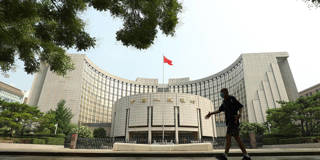The People's Bank of China recently announced a 25-basis-point reduction of banks' mandatory reserve ratio – a move that will free up liquidity and support growth. In fact, China has plenty of space to use monetary expansion to buttress growth, financial stability, and structural reform.
HONG KONG – In 2020, Sebastian Mallaby of the Council on Foreign Relations announced the beginning of the “age of magic money,” in which advanced economies would “redefine the outer limits of their monetary and fiscal power.” By July 2022, Mallaby was predicting that this age was coming to an end. But, while most major central banks are now reversing quantitative easing (QE) and raising interest rates, China may need to head in the opposite direction.
Observers often forget that QE was invented by the Bank of Japan in 2001 as a tool for dealing with balance-sheet deflation. Other tools included a zero interest rate and forward policy guidance. The BOJ’s balance sheet expanded from 20% of GDP in 2001 to 30% by 2006, fueled mostly by purchases of Japanese government securities.
Yet, as Nomura economist Richard Koo observed in 2010, loose monetary and fiscal policy did not spur firms and households to invest or spend, because they remained focused on rebuilding their own damaged balance sheets. So, in 2015, the BOJ, led by Governor Haruhiko Kuroda, introduced so-called quantitative and qualitative easing (QQE).

HONG KONG – In 2020, Sebastian Mallaby of the Council on Foreign Relations announced the beginning of the “age of magic money,” in which advanced economies would “redefine the outer limits of their monetary and fiscal power.” By July 2022, Mallaby was predicting that this age was coming to an end. But, while most major central banks are now reversing quantitative easing (QE) and raising interest rates, China may need to head in the opposite direction.
Observers often forget that QE was invented by the Bank of Japan in 2001 as a tool for dealing with balance-sheet deflation. Other tools included a zero interest rate and forward policy guidance. The BOJ’s balance sheet expanded from 20% of GDP in 2001 to 30% by 2006, fueled mostly by purchases of Japanese government securities.
Yet, as Nomura economist Richard Koo observed in 2010, loose monetary and fiscal policy did not spur firms and households to invest or spend, because they remained focused on rebuilding their own damaged balance sheets. So, in 2015, the BOJ, led by Governor Haruhiko Kuroda, introduced so-called quantitative and qualitative easing (QQE).